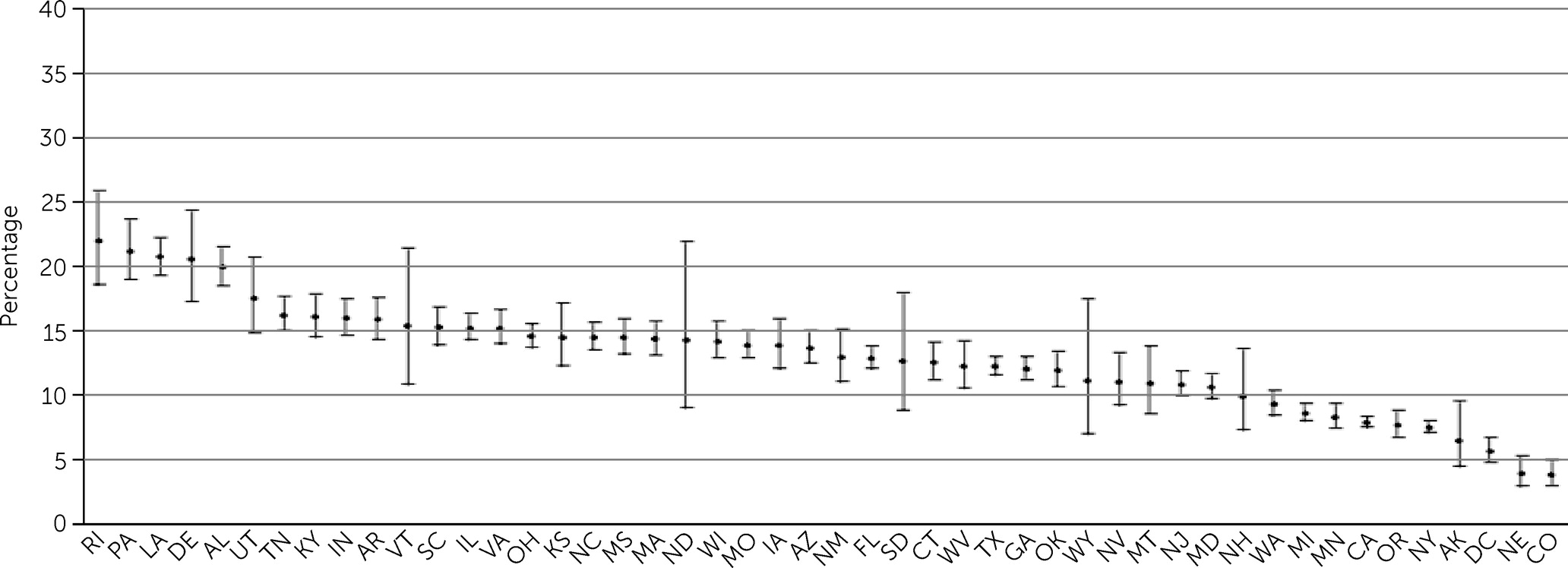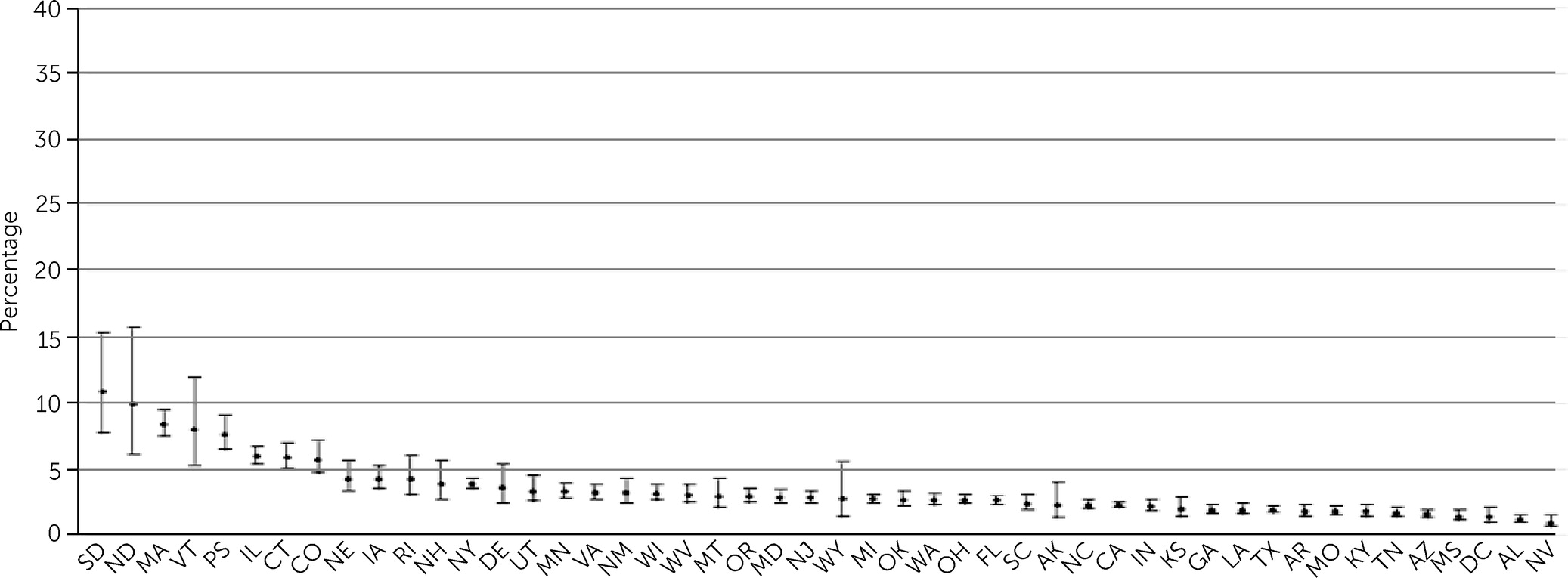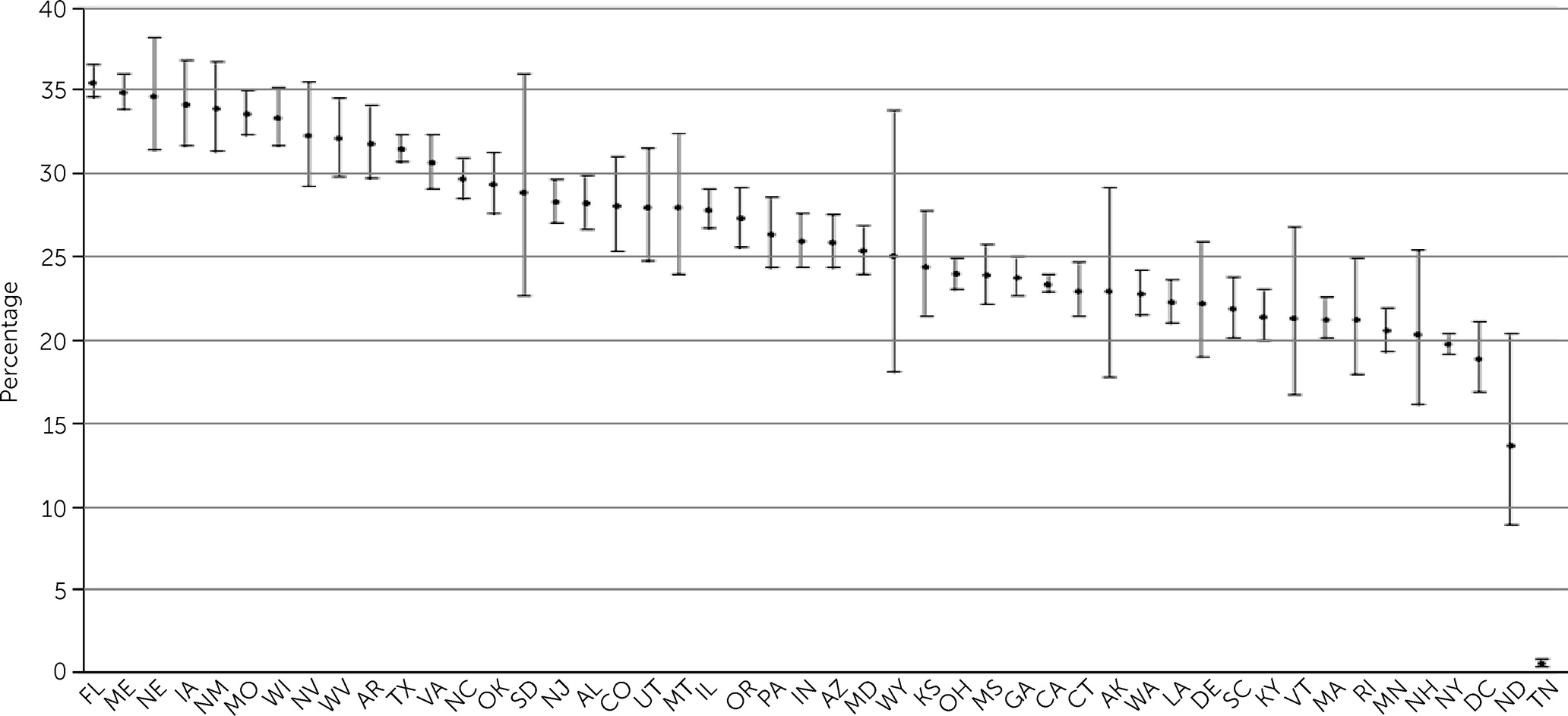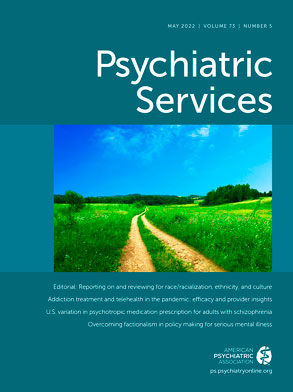Variation in Psychotropic Medication Prescription for Adults With Schizophrenia in the United States
Abstract
Objective:
Methods:
Results:
Conclusions:
HIGHLIGHTS
Methods
Data Source
Cohort Selection
Analysis of Prescription Patterns
Demographic, Clinical, and Service Use Covariates
Analysis Strategy
Results
Sample Characteristics
| Characteristic | N | % |
|---|---|---|
| Age (M±SD years) | 43.2±12.6 | |
| Women | 174,272 | 48.7 |
| Race-ethnicity | ||
| White, non-Hispanic | 141,261 | 39.5 |
| Black, non-Hispanic | 125,256 | 35.0 |
| Hispanic or Latino | 41,262 | 11.5 |
| Otherb | 50,135 | 14.0 |
| Schizophrenia subtypes | ||
| Schizoaffective | 118,930 | 33.2 |
| Schizophreniform | 2,007 | .6 |
| Psychiatric comorbid conditions (2011) | ||
| Substance use disorder | 54,895 | 15.3 |
| Depression | 119,738 | 33.5 |
| Anxiety | 55,468 | 15.5 |
| Deliberate self-harm | 2,796 | .8 |
| General medical comorbid conditions (2011) | ||
| Diabetes | 75,833 | 21.2 |
| Serious cardiovascular disease | 126,636 | 35.4 |
| Hyperlipidemia | 86,153 | 24.1 |
| Financing arrangement | ||
| Fee for service | 246,640 | 68.9 |
| Managed care | 109,017 | 30.5 |
| Otherc | 2,257 | .6 |
| Outpatient visits for schizophrenia | ||
| 0–9 | 217,252 | 60.7 |
| 10–29 | 64,774 | 18.1 |
| 30–49 | 24,852 | 6.9 |
| ≥50 | 51,036 | 14.3 |
| Mental health emergency department visit (2011) | 92,552 | 25.9 |
| Inpatient admission for schizophrenia (N visits) | ||
| 0 | 288,876 | 80.7 |
| 1 | 34,453 | 9.6 |
| 2 | 15,819 | 4.4 |
| 3 | 6,297 | 1.8 |
| ≥4 | 12,469 | 3.5 |
| N of psychotropic medication types taken per year | ||
| 1 | 107,538 | 30.1 |
| 2 | 137,178 | 38.3 |
| 3 | 87,440 | 24.4 |
| 4 | 24,420 | 6.8 |
| 5 | 1,338 | .4 |
| Psychotropic medication typed | ||
| Any antipsychotic | 306,103 | 85.5 |
| LAI antipsychotic | 51,427 | 14.4 |
| Clozapine | 15,679 | 4.4 |
| Antidepressant | 207,531 | 58.0 |
| Mood stabilizer | 99,758 | 27.9 |
| Benzodiazepine | 97,468 | 27.2 |
Demographic, Clinical, and Service Use Predictors of Psychotropic Medication Prescriptions
| Antipsychotic medications | LAI | Clozapine | Antidepressants | Benzodiazepines | Mood stabilizers | |||||||
|---|---|---|---|---|---|---|---|---|---|---|---|---|
| Demographic characteristic | AOR | 99% CIb | AOR | 99% CIb | AOR | 99% CIb | AOR | 99% CIb | AOR | 99% CIb | AOR | 99% CIb |
| Age (continuous) | .99* | .99–.99 | .99* | .99–.99 | .98* | .98–.98 | 1.01* | 1.00–1.01 | 1.01* | 1.01–1.01 | .98* | .98–.98 |
| Women (reference: men) | .81* | .79–.83 | .78* | .76–.80 | .82* | .78–.86 | 1.47* | 1.44–1.50 | 1.38* | 1.35–1.41 | 1.00 | .98–1.02 |
| Race-ethnicity (reference: White, non-Hispanic) | ||||||||||||
| Black, non-Hispanic | 1.16* | 1.12–1.19 | 1.39* | 1.35–1.44 | .40* | .38–.42 | .71* | .69–.73 | .51* | .49–.52 | .69* | .67–.71 |
| Asian | 1.26* | 1.13–1.41 | 1.10 | .99–1.23 | .83* | .72–.96 | .60* | .56–.65 | .63* | .58–.69 | .72* | .66–.78 |
| Hispanic | 1.10* | 1.03–1.17 | 1.26* | 1.19–1.34 | .63* | .57–.69 | .95* | .92–.99 | 1.00 | .95–1.04 | .74* | .71–.78 |
| Native Hawaiian or other Pacific Islander | 1.55* | 1.30–1.84 | 1.26* | 1.11–1.44 | .80* | .66–.97 | .69* | .63–.75 | .63* | .57–.70 | .72* | .65–.80 |
| Schizophrenia subtype (reference: schizophrenia) | ||||||||||||
| Schizoaffective | 1.00 | .98–1.03 | .77* | .75–.80 | .91* | .87–.96 | 1.35* | 1.32–1.38 | 1.14* | 1.11–1.16 | 1.60* | 1.57–1.64 |
| Schizophreniform | 1.15 | .96–1.37 | .91 | .76–1.09 | .77 | .56–1.07 | .93 | .82–1.05 | 1.04 | .90–1.20 | 1.00 | .87–1.15 |
| Psychiatric comorbid condition | ||||||||||||
| Substance use disorder (reference: none) | .82* | .79–.85 | .83* | .80–.87 | .45* | .41–.50 | 1.41* | 1.37–1.45 | 1.09* | 1.06–1.13 | .88* | .86–.91 |
| Depression (reference: none) | .72* | .70–.74 | .65* | .63–.67 | .56* | .53–.60 | 2.06* | 2.01–2.10 | 1.17* | 1.14–1.20 | .92* | .90–.94 |
| Anxiety (reference: none) | .69* | .67–.72 | .66* | .63–.69 | .65* | .60–.70 | 1.41* | 1.37–1.45 | 2.33* | 2.27–2.40 | .88* | .86–.91 |
| Deliberate self-harm (reference: none) | 1.03 | .89–1.19 | 1.02 | .88–1.19 | .92 | .66–1.29 | 1.46* | 1.29–1.66 | 1.07 | .95–1.19 | 1.05 | .94–1.17 |
| Comorbid general medical condition | ||||||||||||
| Diabetes (reference: none) | 1.08* | 1.04–1.12 | 1.06* | 1.03–1.10 | 1.48* | 1.40–1.57 | 1.10* | 1.07–1.13 | 1.08* | 1.05–1.11 | 1.12* | 1.09–1.15 |
| Serious cardiovascular disease (reference: none) | .86* | .83–.89 | .84* | .81–.86 | .98* | .93–1.03 | 1.19* | 1.16–1.21 | 1.30* | 1.27–1.33 | 1.06* | 1.04–1.09 |
| Hyperlipidemia (reference: none) | 1.13* | 1.09–1.17 | .91* | .88–.94 | 1.44* | 1.37–1.52 | 1.07* | 1.05–1.10 | 1.04* | 1.01–1.07 | 1.06* | 1.03–1.08 |
| Financing arrangement (reference: FFS)c | ||||||||||||
| Managed care | .46* | .44–.48 | .81* | .77–.84 | .77* | .72–.83 | 1.24* | 1.20–1.27 | .99 | .96–1.02 | .89* | .86–.92 |
| Other | .23* | .20–.26 | .61* | .50–.74 | .16* | .08–.31 | .24* | .21–.27 | .19* | .14–.24 | .20* | .16–.25 |
| Psychiatric service use | ||||||||||||
| Outpatient schizophrenia visits (reference: 0–9) | ||||||||||||
| 10–29 | 1.94* | 1.86–2.02 | 2.65* | 2.55–2.74 | 2.36* | 2.22–2.51 | .78* | .76–.80 | .86* | .84–.89 | .89* | .86–.92 |
| 30–49 | 2.27 | 2.13–2.42 | 4.25* | 4.06–4.45 | 3.10* | 2.86–3.36 | .75* | .72–.78 | .83* | .79–.87 | .97 | .93–1.01 |
| ≥50 | 2.75 | 2.61–2.88 | 5.32* | 5.13–5.52 | 4.88* | 4.59–5.18 | .73* | .71–.75 | .82* | .79–.85 | 1.15* | 1.12–1.19 |
| Mental health ED visit (reference: none) | 1.18* | 1.14–1.22 | 1.44* | 1.39–1.49 | .77* | .72–.82 | .95* | .92–.97 | 1.12* | 1.09–1.15 | 1.36* | 1.32–1.40 |
| Inpatient schizophrenia admission visit (reference: 0) | ||||||||||||
| 1 | 1.13* | 1.08–1.19 | 1.36* | 1.30–1.43 | .92 | .84–1.00 | .91* | .88–.95 | 1.04* | 1.00–1.08 | 1.30* | 1.26–1.35 |
| 2 | 1.32* | 1.23–1.42 | 1.58* | 1.48–1.69 | 1.01 | .90–1.15 | .83* | .79–.87 | 1.04 | .99–1.10 | 1.45* | 1.38–1.52 |
| 3 | 1.53* | 1.36–1.71 | 1.80* | 1.64–1.98 | 1.12 | .93–1.34 | .83* | .77–.90 | 1.01 | .93–1.09 | 1.71* | 1.59–1.84 |
| ≥4 | 1.51* | 1.39–1.64 | 1.80* | 1.67–1.94 | 1.22* | 1.06–1.41 | .90* | .85–.96 | 1.08* | 1.01–1.15 | 1.75* | 1.65–1.85 |
State Variation in the Prescription of Psychotropic Medications



Post Hoc Analyses
Discussion
Conclusions
Supplementary Material
- Download
- 2.94 MB
References
Information & Authors
Information
Published In
History
Keywords
Authors
Funding Information
Metrics & Citations
Metrics
Citations
Export Citations
If you have the appropriate software installed, you can download article citation data to the citation manager of your choice. Simply select your manager software from the list below and click Download.
For more information or tips please see 'Downloading to a citation manager' in the Help menu.
View Options
View options
PDF/EPUB
View PDF/EPUBLogin options
Already a subscriber? Access your subscription through your login credentials or your institution for full access to this article.
Personal login Institutional Login Open Athens loginNot a subscriber?
PsychiatryOnline subscription options offer access to the DSM-5-TR® library, books, journals, CME, and patient resources. This all-in-one virtual library provides psychiatrists and mental health professionals with key resources for diagnosis, treatment, research, and professional development.
Need more help? PsychiatryOnline Customer Service may be reached by emailing [email protected] or by calling 800-368-5777 (in the U.S.) or 703-907-7322 (outside the U.S.).

